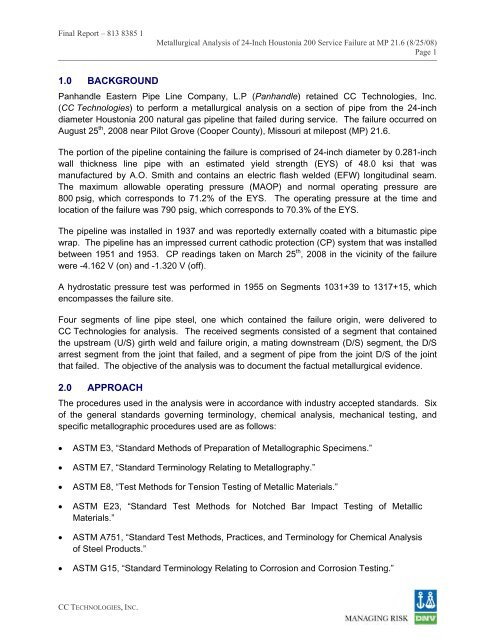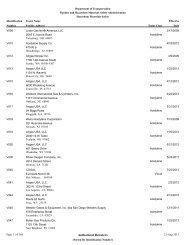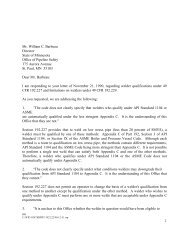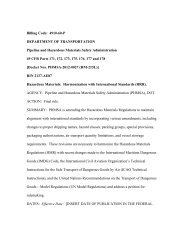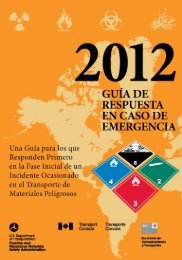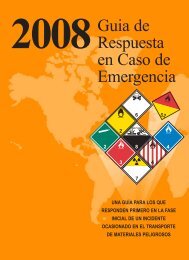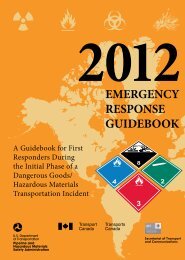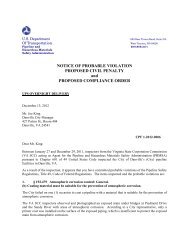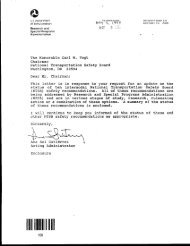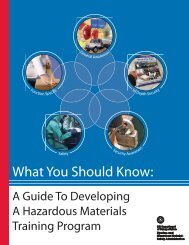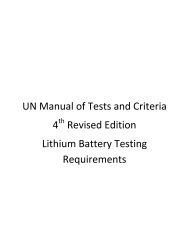Pipeline Failure Investigation Report - PHMSA - U.S. Department of ...
Pipeline Failure Investigation Report - PHMSA - U.S. Department of ...
Pipeline Failure Investigation Report - PHMSA - U.S. Department of ...
Create successful ePaper yourself
Turn your PDF publications into a flip-book with our unique Google optimized e-Paper software.
Final <strong>Report</strong> – 813 8385 1<br />
Metallurgical Analysis <strong>of</strong> 24-Inch Houstonia 200 Service <strong>Failure</strong> at MP 21.6 (8/25/08)<br />
Page 1<br />
1.0 BACKGROUND<br />
Panhandle Eastern Pipe Line Company, L.P (Panhandle) retained CC Technologies, Inc.<br />
(CC Technologies) to perform a metallurgical analysis on a section <strong>of</strong> pipe from the 24-inch<br />
diameter Houstonia 200 natural gas pipeline that failed during service. The failure occurred on<br />
August 25 th , 2008 near Pilot Grove (Cooper County), Missouri at milepost (MP) 21.6.<br />
The portion <strong>of</strong> the pipeline containing the failure is comprised <strong>of</strong> 24-inch diameter by 0.281-inch<br />
wall thickness line pipe with an estimated yield strength (EYS) <strong>of</strong> 48.0 ksi that was<br />
manufactured by A.O. Smith and contains an electric flash welded (EFW) longitudinal seam.<br />
The maximum allowable operating pressure (MAOP) and normal operating pressure are<br />
800 psig, which corresponds to 71.2% <strong>of</strong> the EYS. The operating pressure at the time and<br />
location <strong>of</strong> the failure was 790 psig, which corresponds to 70.3% <strong>of</strong> the EYS.<br />
The pipeline was installed in 1937 and was reportedly externally coated with a bitumastic pipe<br />
wrap. The pipeline has an impressed current cathodic protection (CP) system that was installed<br />
between 1951 and 1953. CP readings taken on March 25 th , 2008 in the vicinity <strong>of</strong> the failure<br />
were -4.162 V (on) and -1.320 V (<strong>of</strong>f).<br />
A hydrostatic pressure test was performed in 1955 on Segments 1031+39 to 1317+15, which<br />
encompasses the failure site.<br />
Four segments <strong>of</strong> line pipe steel, one which contained the failure origin, were delivered to<br />
CC Technologies for analysis. The received segments consisted <strong>of</strong> a segment that contained<br />
the upstream (U/S) girth weld and failure origin, a mating downstream (D/S) segment, the D/S<br />
arrest segment from the joint that failed, and a segment <strong>of</strong> pipe from the joint D/S <strong>of</strong> the joint<br />
that failed. The objective <strong>of</strong> the analysis was to document the factual metallurgical evidence.<br />
2.0 APPROACH<br />
The procedures used in the analysis were in accordance with industry accepted standards. Six<br />
<strong>of</strong> the general standards governing terminology, chemical analysis, mechanical testing, and<br />
specific metallographic procedures used are as follows:<br />
• ASTM E3, “Standard Methods <strong>of</strong> Preparation <strong>of</strong> Metallographic Specimens.”<br />
• ASTM E7, “Standard Terminology Relating to Metallography.”<br />
• ASTM E8, “Test Methods for Tension Testing <strong>of</strong> Metallic Materials.”<br />
• ASTM E23, “Standard Test Methods for Notched Bar Impact Testing <strong>of</strong> Metallic<br />
Materials.”<br />
• ASTM A751, “Standard Test Methods, Practices, and Terminology for Chemical Analysis<br />
<strong>of</strong> Steel Products.”<br />
• ASTM G15, “Standard Terminology Relating to Corrosion and Corrosion Testing.”<br />
CC TECHNOLOGIES, INC.


